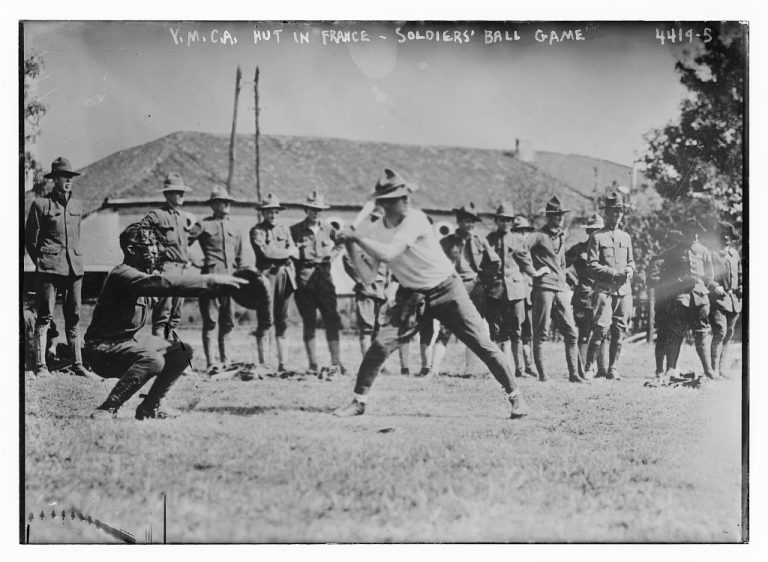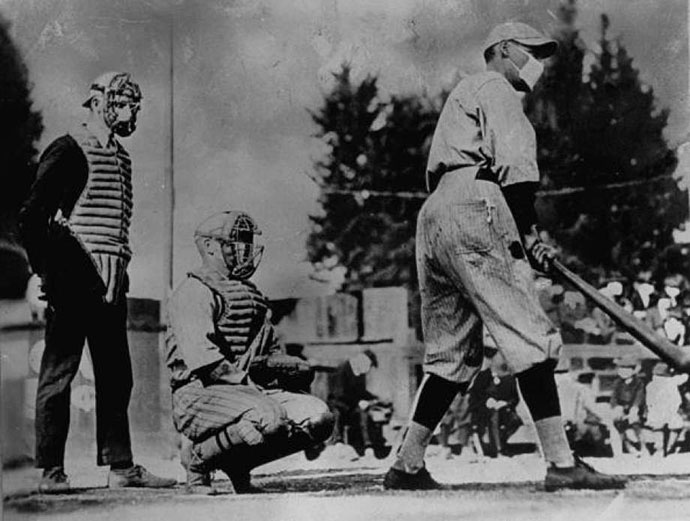Did your history teacher ever ask you, “Does history really repeat itself?” Well, in the case of viruses, it looks like the answer is yes. History seems to be repeating itself along the lines of a rapidly spreading virus right now. A similar pandemic happened about 100 years ago in 1918. There are so many uncertainties right now. Schools, jobs, small businesses, hospitals and clinics, and even baseball have all been affected. However, if history does repeat itself, it looks like baseball is going to be okay.
In 1918, the Spanish Flu made a dark time in America even darker. While the first world war was being fought, there were reports of a quickly spreading illness. It is unknown exactly where the name “Spanish Flu” originated, but Spain was first to report on it in Madrid in late May of 1918. Spain was neutral in World War I and they could report any news without government control. The first case may have been at Fort Riley, Kansas when one man reported feeling ill. Within an hour the hospital was full and the flu killed 46 soldiers based at Fort Riley. This flu was unusual because it targeted the young and healthy, being particularly deadly to 20 to 35 year-olds. When the United States sent soldiers to France, the virus spread all over the world. After developing symptoms, some of the victims would die within hours. Others took days of being hospitalized in quarantined areas alone. Sound familiar?

. , 1917. [or 1918] Photograph. https://www.loc.gov/item/2014705939/.
The 1918 Spanish Flu was a virus that attacked the respiratory system. Viruses that attack the respiratory system are transmitted by an infected person that coughs, sneezes or speaks. Respiratory droplets are generated, transmitted into the air, and can then be inhaled by anyone nearby. When it became known that the virus spread this way, many cities and towns in the U.S. required people to stay home, ordered citizens to wear masks, and shut down public places, including schools, parks, churches, and theaters. In San Francisco, citizens were fined five dollars for not wearing a mask in public. Five dollars in 1918 is equivalent to an eighty-five dollar fine today. The rapid spread of the deadly virus ended up killing between 50 and 100 million people worldwide and 670,000 in the United States. It’s impossible to know the real number because the medical field and record-keeping were not as advanced as the system we have in place today. The spread and the unknown about the Spanish Flu led to a life then that we are familiar with right now – a life in quarantine.
Orders to stay home and stay away from other people are not the only similarities with the Spanish Flu and COVID-19. Sports have also been greatly impacted by both pandemics. The 1918 college football season was interrupted by World War I and the Spanish Flu, very much like our situation right now with COVID-19 and the interruption of local sports, the MLB season, and the NBA season that was already in full force. In 1918, the Major League Baseball season but was initially shortened by World War I, not the Spanish Flu. The government ordered the “Work or Fight” order that mandated the season to be shortened. This meant all the professional players were deemed “Non-essential” and either had to go fight in the war, or go to work for the war cause. Baseball was forced to a halt. The scheduled season was to play 154 games, but shortened to around 126-129 games. The 1918 season is the only time in Baseball’s history to play fewer games than planned as well as The Postseason being held in September!

While the War and the 1918 pandemic were tragic, there was one particular ray of light that came out of this time: The Great Bambino. Babe Ruth played a huge part on the 1918 World Series team the Boston Red Sox (75-51). During the outbreak of the Spanish Flu, a number of players got really sick. In May, Babe Ruth got the virus, but he was able to make a full recovery. The Spanish Flu did hold him to only 95 games that season, yet he still made the legendary name for himself through his performance in the batter’s box and on the mound. Leading up to the 1918 season, Ruth had 4 years of big league experience, accumulating a total of nine home runs. In the 1918 season, he led the league with 11 home runs and won 13 games as a pitcher with an ERA of 2.22. The 1918 World Series showcased the Boston Red Sox (75-51) and Chicago Cubs (84-45). The Red Sox won the series four games to two, then did not win another World Series until 2004. The Runner-up Chicago Cubs did not win a World Series until 2016. Babe Ruth is proof that great players and great teams can rise out of and bring hope to dark times.
So, if history is planning on repeating itself, what can we do to make sure we are ready? How can we adjust our mindset to one of hope? And for you baseball players, how will you make sure that once baseball is up and running again, you are ready for the call?
Dream Big, Serve bigger!

Brandon Dormaier
BASE by Pros Instructor
Sources:
- Berry Tramel, Baseball kept playing during the Spanish Flu, April 5, 2020
- Bill Francis, 1918 FLU PANDEMIC DID NOT SPARE BASEBALL
- History.com, Spanish Flu, October 12, 2010
- Buck Ringgold, Sports: 1918: War and pandemic, April 12, 2020







